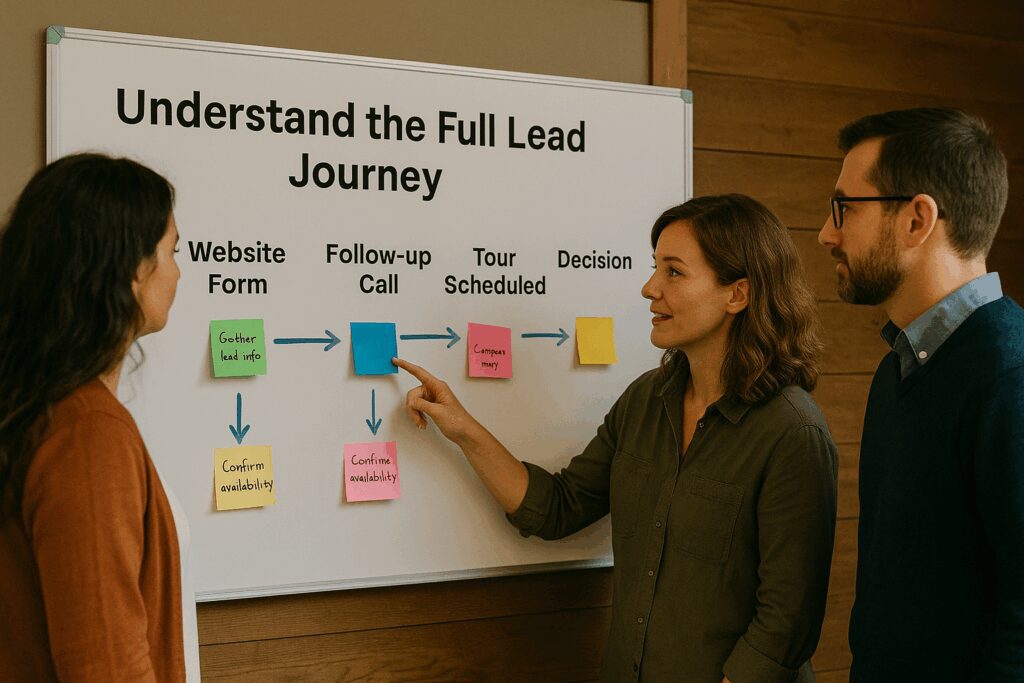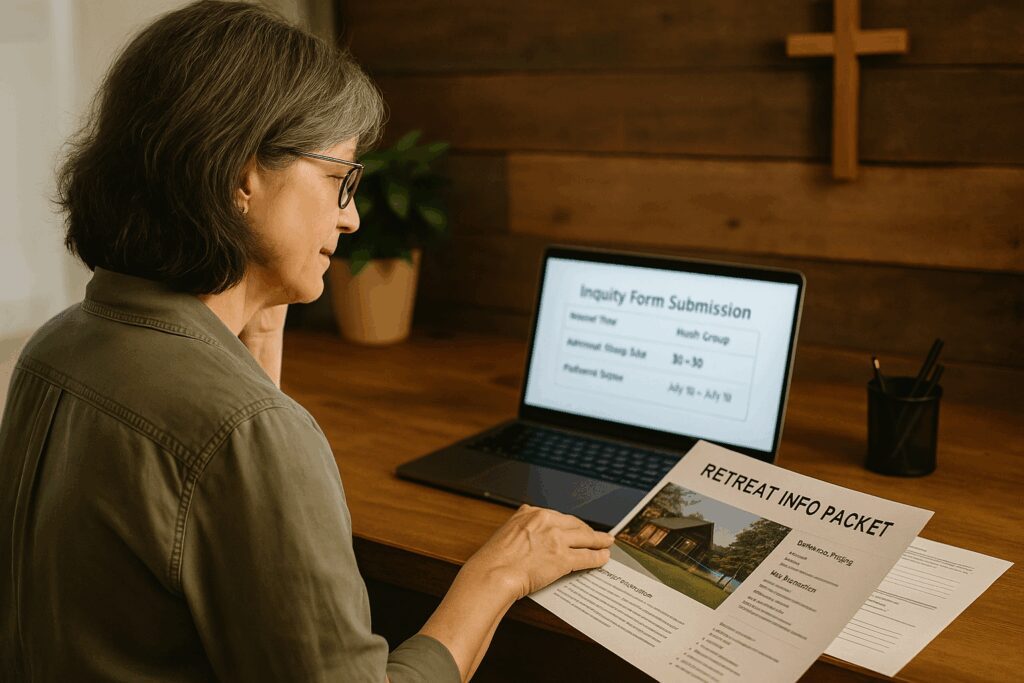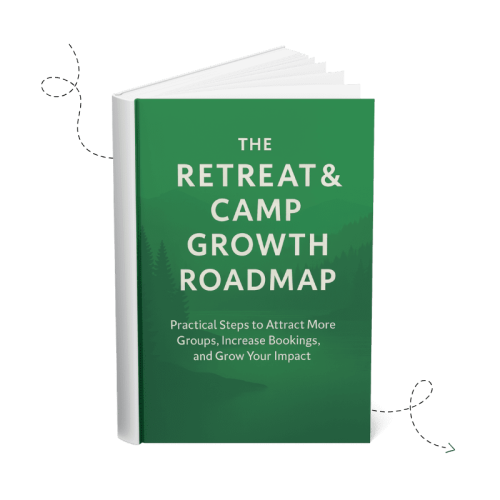Retreat & Camp Growth Roadmap Focus Area: Improve Lead Handling
Introduction
For most retreat centers and camps, early growth comes through personal relationships, referrals, and returning guests. But as you seek to grow beyond your existing network and attract new groups, you’ll need a reliable lead generation strategy—and that means you’ll also need a strong lead management process to match.
A lead management process is how you receive, qualify, and follow up with group inquiries in a consistent, ministry-minded way. It ensures that every inquiry gets timely attention, helpful communication, and a clear next step—making it far more likely they’ll book with you.
Whether leads are coming in via your website, email, or a phone call, how you respond—and how well you track your process—can significantly affect your outcomes.
Why This Focus Area Matters
You don’t need to be a professional salesperson to steward leads well—but you do need a simple, intentional system.
Without a clear process:
- Emails get buried.
- Team members handle leads differently.
- Important details are missed or forgotten.
- Group leaders lose momentum or interest.
Instead, the key is to build clarity into how you market your retreat center, your lead process, and how your team responds to each inquiry. Clarifying your lead process will help you build consistency, improve responsiveness, and increase the number of qualified leads that convert into bookings.
Is This a Focus Area You Need to Work On Right Now?
Even if your team already responds to inquiries, you may not have stepped back to evaluate how consistent, timely, and effective that process truly is. This section will help you assess your current lead management practices and identify where improvements can be made to better serve prospective guests and increase your booking success rate. Ask yourself:
- Do you consistently know where your leads are coming from?
- Are your forms and conversations collecting the right information to qualify leads?
- Is it clear what your team should do when a lead comes in via phone, form, or email?
- Do you have a consistent approach for setting next steps and timelines?
- Are leads tracked in a way that allows easy handoff and follow-up?
If you answered “no” to any of these, this focus area will help you build clarity, confidence, and results.
How to Apply This Focus Area
Understand the Full Lead Journey
Before you can improve your lead management, you need to understand how inquiries currently come into your organization and what happens next. Every retreat center has its own unique mix of communication channels—forms, calls, emails, and social media messages.
For Christian camps and ministries, aligning your lead journey with faith-driven values is just as important as applying practical SEO for Christian camps and retreat centers, since both help you connect with aligned groups searching online. By mapping the full journey of a lead, you can spot inconsistencies, gaps, or missed opportunities and start designing a process that brings clarity and care to every new inquiry. Start by mapping all the ways leads come to your retreat center:
- Website inquiry form
- Direct email
- Phone call
- Social media message
Your process should account for how each type of inquiry is received and what happens next—from acknowledgment to follow-up.
To effectively steward a new inquiry, you need to gather the right information right away—no matter how the lead contacts you. Each entry method (form, phone, or email) offers its own opportunities and challenges. Your goal is to ensure you’re collecting key details that allow your team to respond helpfully and move the conversation forward.

Capture the Right Information From the Start
For Website Forms:
In today’s digital-first world, many retreat inquiries begin with a web form. That makes your inquiry form one of the most important tools in your lead process. It’s often your first impression—and your first chance to collect the information you need to qualify and respond to a lead effectively.
Your inquiry form should ask for the essentials to help your team qualify the lead. Include:
- Group name and type (church, school, ministry, etc.)
- Expected number of attendees
- Preferred retreat dates or season
- Type of retreat (youth, women’s, leadership, etc.)
- Contact information (email and phone)
- How they heard about you
Once submitted, best practice is to:
- Show a confirmation message with basic next steps
- Trigger an autoresponder email that acknowledges their inquiry, shares helpful info (like a retreat info packet, pricing guide, or campus map), and lets them know when they can expect to hear from your team.
Why does this matter? According to studies by Harvard Business Review and Lead Response Management, organizations that respond to leads within 5 minutes are up to 21 times more likely to engage them compared to waiting just 30 minutes. Even an automated response can help you stay top of mind while buying interest is highest.
For Phone Calls:
Despite the prevalence of web forms, many people still prefer to call directly—especially if they have specific questions, complex group needs, or just want to get a sense of your hospitality before filling out a form. Phone calls are often the first real personal interaction a potential guest has with your team, so it’s important to treat them as an opportunity to build trust and start qualifying the lead.
Speed matters here too. According to InsideSales.com, responding to a phone lead within the first 5 minutes increases the likelihood of qualifying that lead by 21 times compared to waiting just 30 minutes. If you miss a call, return it as soon as possible—ideally within 15–30 minutes.
Train your team to answer the phone with warmth and clarity. Provide a short intake script that covers:
- Who’s calling and why
- Basic qualifying info (group type, size, date interest)
- How they heard about you
- Schedule Next steps (depending on your internal process and the call result, this could be scheduling a initial call with a retreat coordinator, sending a formal estimate or scheduling a facility tour)
- Follow Up Info (depending on your internal process and call result, this could be sending out an information packet, sending a meeting invite, or confirmation of a facility tour time)
Even if the conversation is informal, write down the info somewhere—ideally in a shared CRM or spreadsheet.

For Emails:
Reply promptly with a warm, personal message. Studies show that the chance of connecting with a lead drops significantly after the first hour. Aim to reply to email inquiries within 30–60 minutes whenever possible to increase engagement.
Reinforce the next step clearly, whether that’s setting up a call, sending info, or inviting them to a tour.
Use email templates to ensure consistency, and always include helpful resources (a retreat planning guide, pricing info, or testimonials).
Example:
Hi Sarah,
Thanks so much for reaching out about planning a women’s retreat at our center! We’d love to learn more about your group and how we can help you create a meaningful experience.
I’ve attached our retreat information packet, which includes pricing, available facilities, and a sample schedule. If it’s helpful, we’d be happy to schedule a short call to talk through your plans and answer any questions.
Let me know what days/times work best for you, or feel free to use this link to book a call directly: [Scheduling Link]
Looking forward to connecting soon!
Warmly,
[Your Name]
Guest Services Coordinator
Define and Qualify the Lead Through an Initial Call
Information gathered from an initial form, email, or phone inquiry often provides a basic sense of whether a group might be a good fit—but it’s rarely enough to move forward with scheduling or estimating. To truly understand their needs and assess the opportunity, a structured follow-up conversation is essential.
This qualification call (or Zoom meeting) helps you:
- Confirm the group’s purpose, size, and alignment with your retreat offerings
- Determine availability and whether their preferred dates are realistic
- Uncover any key details not included in the initial inquiry
- Begin to build a relationship rooted in trust and ministry partnership
Typical qualification criteria include:
- The lead is planning a group event (not a personal getaway)
- The group fits your size and lodging capabilities
- The dates requested are available or flexible
- The retreat purpose aligns with your mission and focus areas
During the call, ask open-ended questions like:
- “Can you tell me more about the purpose of your retreat and who will be attending?”
- “What are the top goals or outcomes you’re hoping to achieve with this retreat?”
- “Are there any specific facilities, accommodations, or support services you’re looking for?”
In addition to gathering information, the call allows you to:
- Clarify where they are in their planning process and how soon they’re looking to book
- Address common concerns or objections (e.g., pricing, availability, location)
- Offer a ballpark estimate or walk through pricing details
- Invite them to schedule a tour or receive a formal proposal
Close the conversation by clearly defining the next step and timeline. For example: “I’ll send over a preliminary estimate later today and follow up with you next Tuesday to see if you’d like to move forward with a tour.”
If you discover the group is not a fit for your center, thank them warmly for their interest and, when possible, recommend another facility. A thoughtful referral can turn a “no” into a future positive impression or referral down the road.
Create a Simple Follow-Up Rhythm
It’s easy to forget that leads may be comparing multiple options—or just plain busy. But statistically, follow-up is where most organizations lose leads. According to industry research, 80% of sales require at least five follow-ups after the initial contact—but nearly half of people give up after just one.
That’s why a thoughtful, consistent follow-up process is essential. It builds trust, shows professionalism, and helps guests move forward with confidence.
Use a 3-touch follow-up rhythm to start:
- Initial reply: Within 24 hours. Research shows that responding within 5 minutes increases your chance of connecting with a lead by up to 9x compared to waiting just one hour.
- Follow-up #1: After 3–4 days. Ask if they had a chance to review the info and offer a planning call.
- Follow-up #2: After 7–10 days. Offer to answer any lingering questions and clarify that you’ll close out the inquiry if you don’t hear back.
You can follow up in a few different ways:
- Personal emails (short, friendly, and customized)
- Text messages (great for quick nudges or scheduling reminders)
- Phone calls (especially for warm leads who’ve already expressed interest)
- Automated email sequences (great for leads not quite ready to book—more on this in Stage 3)
Mark leads as “active,” “paused,” or “cold” so your team knows where they stand and what actions are needed next.

Use a Lead Tracking System
Tracking can be as simple or advanced as your team needs—but it must exist.
At a minimum, track:
- Name and contact info
- Group type and size
- Lead source (how they found you)
- Status (new, in conversation, proposal sent, booked, closed)
- Notes and next steps
A shared spreadsheet works fine to start. A CRM makes it easier as volume grows—we’ll walk through setup in Step 2: Build Your Platform.
Lead Qualification Worksheet
Our Lead Qualification Worksheet is designed to help you and your team map out what information should be collected during both the initial inquiry and the follow-up call. Instead of using it as a form to record individual lead data, this worksheet acts as a planning tool. It helps you clarify the fields and criteria you want to include in your web inquiry forms, phone intake scripts, and retreat coordinator follow-up processes.
The worksheet includes two main sections:
Section 1: Initial Inquiry Information Use this section to define what your team should collect through web forms, phone intake, or email inquiries. It also includes space to set clear pre-qualification criteria to help determine if a lead is ready for a follow-up call.
Section 2: Follow-Up Call Information This section helps you identify the additional information you’ll want to gather during a phone call with the prospective group leader. It includes options for event details, decision-making timelines, budget, accommodations, and more—plus final qualification criteria to determine if the lead is ready for an estimate or proposal.
📥 Download the Lead Qualification Worksheet
📥 Download an Example of a Completed Lead Qualification Worksheet
Practical Examples
- A retreat center added group type and date fields to their inquiry form, plus an autoresponder with their retreat info packet. Inquiries became more qualified and easier to convert.
- A camp trained their front desk to ask key qualifying questions on calls and record them in a shared Google Sheet. This allowed smoother handoffs to their booking coordinator.
- A center created a phone and email script for all first contacts. This helped even part-time or seasonal staff provide a consistent, welcoming experience.
Putting It All Together
Clarifying your lead process means:
- Gathering the right information across all entry points
- Responding with warmth, clarity, and helpful next steps
- Following up consistently with qualified leads
- Tracking your process so you can learn and improve
When your team follows the same playbook, you’ll stop missing opportunities—and start booking more mission-aligned groups. Paired with intentional marketing strategies for retreat centers, a strong lead process helps you reach more people, serve them well, and steadily increase bookings.
Practical Takeaways
- Map out all the ways leads enter your system
- Update your inquiry form to collect qualifying info
- Write or revise your call and email scripts
- Define your qualification criteria as a team
- Set a clear follow-up schedule (3 touches minimum)
- Track every lead with a spreadsheet or CRM
Ready to Take the Next Step?
Clarifying your lead handling process ensures no inquiry falls through the cracks—and every potential guest is welcomed with clarity, consistency, and care. When your team responds with purpose, you create a smoother experience for both guests and staff.
If you found this helpful, here are four great next steps to continue your journey:
🧭 Move to the Next Focus Area: Launch Lead-Ready Website
Design and launch a lead-ready website that communicates your mission and captures inquiries effectively.
[Read Launch Lead-Ready Website Article]
📘 Download the Retreat & Camp Growth Roadmap eBook
Get the full 3-stage system we use to help Christian retreat centers and camps grow with clarity and purpose.
[Download the eBook]
🌱 Learn More About How We Help Retreat Centers & Camps
We’re a Christian-owned marketing agency that helps ministries grow attendance, bookings, and impact through practical strategies rooted in clarity and stewardship.
[See How We Can Help]
🤝 Schedule a Free Discovery Call
Want help applying this to your unique situation? Let’s talk. We’ll explore where you are now, where you want to go, and how to take the next faithful step.
[Book a Discovery Call]
You don’t have to figure this out alone. Let’s build something meaningful—together.
Frequently Asked Questions
1. What if we don’tWhat if our retreat center doesn’t get that many inquiries yet?
That’s actually the perfect time to develop a clear and consistent lead handling process. With fewer leads, you can give each one the attention it deserves while building good habits. Investing in this now will ensure you’re ready when inquiries start to grow—and it helps you book more of the leads you already have.
2. We’re a small camp—do we really need a CRM?
If you’re handling a manageable volume of leads with just one or two people, a shared spreadsheet may be enough. But even small camps and retreat centers benefit from using a CRM once you have multiple follow-ups, team members, or communication threads. A CRM ensures nothing falls through the cracks, helps track conversations, and improves collaboration as your team grows.
3. How fast should we respond to inquiries?
As quickly as possible. Studies show responding within 5 minutes can increase your chance of connecting by up to 9x. Even if you can’t fully respond right away, a quick acknowledgment or auto-responder helps assure the guest that their inquiry was received and sets expectations for next steps.
4. Should we keep follow up with leads if they don’t reply?hey don’t reply?
Yes, and it’s critical. Most leads don’t convert after just one touchpoint. Industry stats suggest it can take 3–5 contacts to engage a decision-maker. A kind, consistent follow-up rhythm shows professionalism and commitment to helping them plan a meaningful retreat.
5. What if our booking process varies by group type? type?
It’s completely fine for your process to adapt based on different group types, such as youth, women’s, or leadership retreats. Just make sure you have clear templates or intake forms tailored to each audience. Documenting these variations helps your team apply the right process consistently and confidently.
6. Who should be responsible for lead follow-ups?
Every lead needs a clearly assigned point person—no matter how big or small your team is. Assigning ownership helps prevent confusion, duplication, or dropped communication. If your team rotates responsibilities, make sure each lead’s status and notes are clearly documented and accessible.
7. How do we know what’s working?
Begin by tracking basic conversion data—how many inquiries result in bookings, and at what stage leads tend to drop off. Use a shared spreadsheet or CRM to note each lead’s source, status, and follow-up history. Over time, this data helps you identify trends, improve weak points, and make better decisions about marketing and communication.
8. Can we automate parts of our lead follow up?
Yes—and automation can be a big help, especially for smaller teams. Start with an autoresponder email that acknowledges the inquiry and shares key information. As you grow, you can use email sequences, appointment scheduling tools, and CRM automation to streamline follow-up. We’ll go deeper into lead nurturing automation in Stage 3.
9. What should our inquiry form include?
Keep your form concise but effective. At a minimum, gather the group type, size, preferred dates or season, retreat purpose, contact info, and how they heard about you. This gives your team enough context to determine whether the lead is worth pursuing and how to tailor your response.
10. What do we say in an initial call or email?
Start by thanking them for reaching out and expressing enthusiasm for helping them plan their retreat. Ask a few clarifying questions to learn more about their needs, and offer a clear next step such as setting up a planning call, sending a proposal, or scheduling a tour. Always close with a friendly tone and an invitation to continue the conversation.





